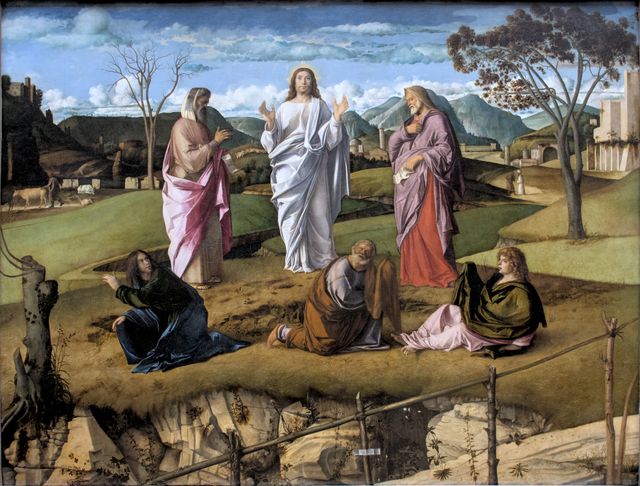
Second Sunday of Lent
Jesus’ Transfiguration points to the Truth and beyond. It lets us see Him in His glory and behold the realm of His Divinity. This is the ultimate Promised Land.
Gospel according to Luke 9:28b-36
Jesus took Peter, John, and James and went up the mountain to pray. While he was praying his face changed in appearance and his clothing became dazzling white. And behold, two men were conversing with him, Moses and Elijah, who appeared in glory and spoke of his exodus that he was going to accomplish in Jerusalem. Peter and his companions had been overcome by sleep, but becoming fully awake, they saw his glory and the two men standing with him. As they were about to part from him, Peter said to Jesus, “Master, it is good that we are here; let us make three tents, one for you, one for Moses, and one for Elijah.” But he did not know what he was saying. While he was still speaking, a cloud came and cast a shadow over them, and they became frightened when they entered the cloud. Then from the cloud came a voice that said, “This is my chosen Son; listen to him.” After the voice had spoken, Jesus was found alone. They fell silent and did not at that time tell anyone what they had seen.

Reflections
This Sunday’s passage begins with an invitation. Jesus invites Peter, John and James to climb a mountain with Him. The scene is reminiscent of Moses on Mount Sinai, where he saw the burning bush and heard the voice of God (Exodus 3:1-15). Climbing the mountain symbolizes stepping away from the noise of daily life, to pray and seek a personal connection with our Heavenly Father. In this way, we are shown an aspect of Christ’s humanity. Even as the Son of God, Jesus needed times of retreat. We are reminded that our spiritual growth requires intentional pauses and times of silence. Just as the Disciples were called to rest from their duties, we too need to create space so that we can encounter God. Our encounters may be found through the sacraments of the Church, through quiet reflection, and with the Holy Spirit speaking through the Scripture.
The Transfiguration occurs just after Jesus first prays about His passion, which teaches us that moments of spiritual renewal will not always shield us from hardship. Rather, they will give us the strength to confront our trials. St. Peter wanted to remain in the time of consolation. Although it may be comforting to linger in moments of solace, Jesus calls us to trust Him to lead us back down the mountain, ready to confront the challenges in our lives.
Jesus’ clothes become “dazzling white” (Luke 9:29). This color is qualitatively different from any type of white that is possible to produce on earth and marks His purity. It foreshadows the Heavenly Body that Jesus will have after the resurrection, as well as our own resurrection. (1) The prophets Moses and Elijah are representatives of the First Covenant and God’s faithfulness to his promises. The Law now being fulfilled with Jesus’ ministry and leading His people toward an Exodus and a Promised Land. (2)
Upon seeing this grandeur, Peter is amazed. The scene is beyond imagination; a truly peak experience for the disciples. From here one can see the past, as it has been, behold the present and look forward to the future with hope. “Master it is good that we are here…” says Peter as all his anxieties and worries are left behind in the valleys (Luke 9:33). In the presence of greatness, there is only a fear of the Lord, ecstasy, and joy. (3) Peter exclaims, “...let us make three tents, one for you, one for Mose and one for Elijah” (Luke 9:33). With this offer, he wishes to build an earthly dwelling for the Prophets so they can enjoy this moment as if for eternity. “But he did not know what he was saying…” (Luke 9:34) because when the cloud covered Jesus, the Father confirmed, yet, for a second time after Jesus’ baptism that Jesus is His Son. The exhortation “Listen to Him” (Luke 9: 35) confers authority upon Jesus greater than the Prophets. His presence, while veiled from the eyes of the multitude, hides Divine presence, a prelude to the transubstantiation, His presence in the Eucharist. The Transfiguration points to how things really are. Seeing through. Transubstantiation is seeing beyond our human realm. (4)
The reaction of the apostles was stunned silence. This is what happens to most of us when we are in awe and there are no words to put into the words the feelings and the awareness of what has been taking place. This is not a dead silence but a silence that speaks volumes. The apostles have witnessed and understood that they were standing on holy ground and witnessing Holy events take place right in front of them. This experience is to imbue them with a sense of mystery and awe and strengthen them for the challenges ahead.
The good news is that God’s presence is promised to us in the Eucharist during the Mass and the sacred ground is everywhere where God is manifested and welcomed. Worshipping Him with praise is fitting. Worshipping Him in the silence of the hearts where we prepare Him room to dwell is even more proper. He comes and strengthens us for the journey ahead.
References
- Leonard, H. (2021). The Transfiguration Points to Our Own Resurrection. Retrieved from: www.catholicstand.com. Accessed: March 14, 2025
- Esparza, D. (2019). Moses, Elijah, and Jesus: Why are they all together at the Transfiguration? Retrieved from: aleteia.org Accessed: March 14, 2025
- St. Augustine’s Parish (2025). Be Afraid? Retrieved from: staugustinesparish.ca Accessed: March 14, 2025
- Longenecker, D. (2025). A Glimpse of Transfiguration at Mass. Retrieved from: dwightlongenecker.com/a-glimpse-of-transfiguration-at=mass/ Accessed: March 14, 2025